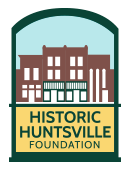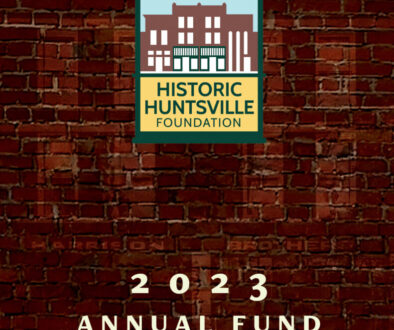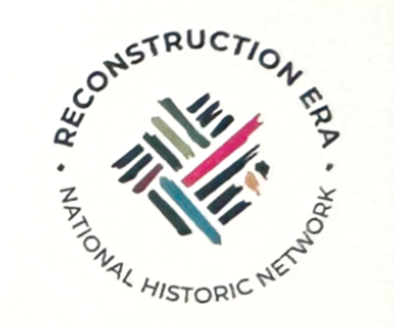The Huntsville Jewish Heritage Center – Huntsville’s Museum with a Mighty Purpose

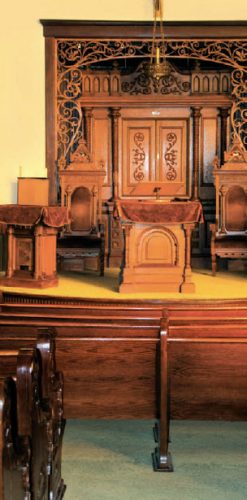 The Huntsville Jewish Heritage Center at the Temple B’nai Sholom explains the religion and traditions of Judaism, provides a history of Huntsville’s Jewish popula-tion, and shares the many contributions of the Jewish community to Huntsville’s civic and cultural life. Located in the original study used by Temple rabbis, the artful displays of the Heritage Center weave together an overarching narrative that offers great insight into the Jewish religion and asks visitors of all faiths to reflect upon the beliefs shared in common.
The Huntsville Jewish Heritage Center at the Temple B’nai Sholom explains the religion and traditions of Judaism, provides a history of Huntsville’s Jewish popula-tion, and shares the many contributions of the Jewish community to Huntsville’s civic and cultural life. Located in the original study used by Temple rabbis, the artful displays of the Heritage Center weave together an overarching narrative that offers great insight into the Jewish religion and asks visitors of all faiths to reflect upon the beliefs shared in common.
This ambitious project began with a simple request. Temple rabbi Elizabeth Behar asked Margaret Anne Goldsmith to convert the original rabbi’s study into a museum. Without hesitation Margaret Anne agreed to this task. As she explains, “I knew it would please my ancestors.”

Margaret Anne and her ancestors are rooted in the history of Temple B’nai Sho-lom and of Huntsville. Her great, great grandparents, the Bernsteins and Hersteins, were founding members of the 1876 B’nai Sholom congregation. Her great grand-father, Isaac Schiffman chaired the 1899 Temple building committee, and her great grandfather Oscar Goldsmith was a member of the building committee. The contributions of Margaret Anne’s family to our city are recognized in the I. Schiffman Building, the names of streets, and in the names of a ball field, an elementary school, and a wildlife sanctuary donated to the city of Huntsville in memory of the Goldsmith and Schiffman families.
With deep ties to Temple B’nal Sholom and the greater Huntsville community, Margaret Anne brought a unique perspective to the museum project. She states, “I believed the Heritage Center would be a way to teach, inform and share with our visitors information about Jewish beliefs, holidays, life cycle events and our sacred Jewish objects, rituals and traditions. We have no efforts to proselytize. After visiting the Center, we want guests to leave with a better under-standing of our similarities and our differences and celebrate both.” And this endeavor, she knew, would
please her ancestors.
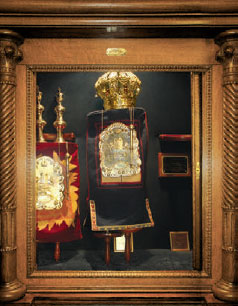
Temple B’nai Sholom has anchored the corner of Lincoln Street and Clinton Avenue since 1899 and is the oldest synagogue building in continuous use in the state of Alabama. The congregation purchased the land for $1,500 in 1898 and contracted with William Meyers of New York to build their house of worship. Architect B. H. Hunt of Chattanooga designed the Romanesque Revival-style synagogue as well as other religious structures across the southeast, including the First Baptist Church that once stood at the corner of Clinton and Church Street.
The Heritage Center is located in the original rabbi’s study, which is on the northeast corner of the sanctuary building. Marking the entrance to the Center is a collection of beautifully framed Torah covers. The Torah, which is handwritten in Hebrew, is Judaism’s central text. It conveys the foundational stories and laws of the Jewish people, including the Five Books of Moses, Genesis through Deuteronomy. The Torah is handwritten in Hebrew and rolled around two ornate wooden shafts, attached to either end of a scroll. As a sign of reverence, the Torah is covered with a cloak, or cover. The Torah covers displayed at the entrance of the Heritage Center are highly decorative, with gold embroidery and beading.
Christopher Madkour of the Huntsville Museum of Art described the Heritage Center as an “exquisite jewel box.” The original mantel, stained glass windows and rich wood floors and moldings impart great warmth to the room. The roll top desk is part of the Temple’s furniture collection and has been used by rabbis since the synagogue’s construction. The space has an air of quiet restfulness, as one feels the pres-ence of the scholars who studied, contemplated and wrote here in past years.
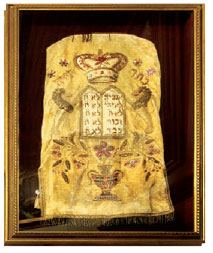
The Heritage Center introduces visitors to Judaism through a series of exhibits that illustrate the beliefs, cul-ture and history of Judaism from its ancient origins to the establishment of the State of Israel in 1948. In a display dedicated to Jewish Memorial and Celebration Days, photographs and donated artifacts explain Jewish life events. Photographs donated by Temple members show the celebration of a Brit Milah, or Bris, where Jewish males are circumcised at eight days old; the Bar and Bat Mitzvah, a ceremony marking the initiation of thirteen year old boys and girls into the Jewish community; the Jewish wedding ceremony, where couples take their marriage vows under a Chuppa, or a wedding canopy made of cloth or garland. Exhibited is a candle used during Shiva, a seven-day period of mourning when relatives mourn the death of a loved one.
The observance of Shabbat is integral to these life events. Shabbat is Judaism’s day of rest, which begins at sundown Friday night and continues until Saturday evening. Temple members donated Shabbat Candles, Kiddush Cup, and Havdalah set used during the Havdalah ceremony at the close of Sabbath.
A second display case introduces visitors to Jewish holidays. The High Holy Days of Judaism are Rosh Hashanah, the Day of Judgment, and Yom Kippur, which is a day of fasting that climaxes the ten-day period of atonement that begins on Rosh Hashanah. Displayed is a Shofar, or ram’s horn, sounded in the synagogue on Rosh Hashanah and at the conclusion of Yom Kippur. Also displayed is a silver sculpture of a Shofar.
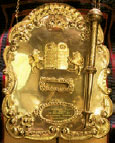
The Jewish holiday of Hanukkah commemo-rates the rededication of the Temple in Jerusalem in 165 BCE following its defilement by the Greeks. Jews celebrate Hanukkah by the lighting of eight candles or oil lamps. Displayed are two Menorahs donated by Temple families.
The Passover Seder is a ritual meal that commemorates the Jewish people’s deliverance from Egypt. Displayed are items used during the Seder, including the Haggadah, which is a liturgy recited during the Seder, and Seder Plates, which hold symbolic foods eaten during the reading of the Haggadah.
One of the most unforgettable artifacts in the Heritage Center is a yellow, cloth Star of David, which was sewn on the jacket of a Jewish Holocaust victim. During the Holocaust Jews were required to wear yellow stars on their clothing. The framed star represents the Holocaust Memorial Day of Yom HaShoah, the day of mourning for victims of the Holocaust. A Temple congregant donated this artifact.
A copy of the Declaration of the State of Israel is also displayed, marking Yom Ha’Atzmaut, which is a holiday commemorating the Establishment of the State of Israel in 1946.
Items in a third display case introduce visitors to Jewish symbols, sacred objects and traditions. The Seven-Branch Menorah and the Magen David, or Star of David, have represented Judaism since ancient times. Jewish homes and synagogues collect funds for righteous causes in the Tzedakah Box. Jewish homes are marked by a Mezuzah, which is affixed to doorposts and contains handwritten passages from the Book of Deuteronomy.
There are three items displayed traditionally worn by Jewish men during prayers and services. A Tallit, or prayer shawl, is worn during morning prayers, Sabbath and holiday services. A Tefillin is two boxes containing handwritten Scriptural quotations. The boxes are bound with leather and strapped to the forehead and weaker arm and worn during daily morning prayers. A Yarmulke, or skullcap, covers the head of men as a sign of humility before God.
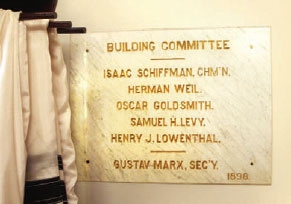
Visitors can learn about the history of Huntsville’s Jewish community through a video documentary that is shown in the Heritage Center. The film begins with the arrival of Huntsville’s first Jewish settlers and traces the evolution of the Jewish community over the decades. Explored is the role of Huntsville Jews in slavery and the Civil War, the impact of urbanism and nativism on the Huntsville Jewish community, and changes to the Jewish community with the arrival of Huntsville’s space program in the 1950s. Through this beautifully produced documentary, visitors learn about the contributions of Jews to our city and gain a deeper appreciation for the cultural diversity of Huntsville.
The Jewish Heritage Center is clearly a labor of love. Meticulously organized and curated by Margaret Anne Goldsmith, the exhibits of the Heritage Center educate visitors about Judaism in a personal way–through the memories, photographs and family heirlooms donated by members of the congregation who want to share their religion with their neighbors and the larger community. At a time of great division in our nation and around the world, the Heritage Center shows the power of a still, small voice.
Sholom.
